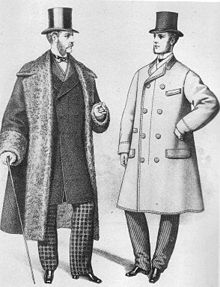कोट (वस्त्र)
कोट ऊपरी शरीर के लिए एक बाहरी वस्त्र है।[1][2] इसे गर्मी या फैशन के लिए पहना जाता है। कोट में आमतौर पर लंबी आस्तीन होती है और सामने की तरफ खुली होती है, बटन, ज़िपर, वेल्क्रो, टॉगल या बेल्ट से बांधी जाती है। यह आम तौर पर कमीज़ या कुरते के ऊपर पहना जाता है। कोट को औपचारिक पहनावा माना जाता है। कोट की लंबाई और शैली फैशन और उपयोग के हिसाब से बदलती रहती है।[3]

ऑक्सफोर्ड इंग्लिश डिक्शनरी के अनुसार "कोट" का आधुनिक अर्थ लगभग 1300 के आसपास है, जब इसे "कोटे (cote)" या "कोट्टे (cotte)" लिखा जाता था। यह पुरानी फ्रेंच और लैटिन के "कॉटस (cottus)" से आया है[4] और अंततः ऊनी कपड़ों के लिए प्रोटो-इंडो-यूरोपीय शब्द से निकला है।[5]
इतिहास
संपादित करेंपश्चिमी शैली के कोट की उत्पत्ति यूरेशियन स्टेप्स में सीथियन खानाबदोशों द्वारा पहने जाने वाले आस्तीन वाले, कसकर फिट होने वाले कपड़ों से हुई है, इसी तरह की शैलियाँ चार हज़ार साल पुरानी तारिम ममियों और पाँच हज़ार साल पुराने ओत्ज़ी में पाई गई हैं।[6][7][8][9][10]
मध्ययुगीन और पुनर्जागरण काल के दौरान, कोट पुरुषों और महिलाओं दोनों के लिए एक मध्यम लंबाई वाला, आस्तीन वाला बाहरी परिधान बन गया, जो कमर पर फिट होता था और सामने बटन वाला होता था। अठारहवीं शताब्दी तक, कोट ने लोकप्रिय बाहरी वस्त्र के रूप में केप और लबादे की जगह लेना शुरू कर दिया। बाद में औद्योगिक क्रांति ने कपड़े को और अधिक किफ़ायती बना दिया, जिससे निम्न सामाजिक वर्गों को पहले अमीरों के लिए आरक्षित फैशनेबल कोट अपनाने की अनुमति मिली।[11]
उन्नीसवीं शताब्दी में, सिलाई मशीन और कपड़ा मशीनरी ने बड़े पैमाने पर उत्पादित कपड़ों के उदय में योगदान दिया, जिससे कोट और जैकेट की लोकप्रियता बढ़ गई। बीसवीं शताब्दी के मध्य तक, "जैकेट" और "कोट" आधुनिक शैलियों के लिए अधिक विनिमेय हो गए, हालाँकि पुराने कपड़ों के लिए अंतर बने हुए हैं।[12]
प्रकार
संपादित करें- ओवरकोट: घुटनों तक या उससे भी नीचे तक लंबे, सर्दी में पहने जाते हैं।
- ट्रेंच कोट: बारिश और हल्की ठंड से बचाव के लिए, घुटनों तक।
- पीलकोट: कमर से थोड़ा नीचे तक, ऊनी, नौसेना स्टाइल।
- ब्लेज़र: औपचारिक, स्कूल/क्लब का प्रतीक, छोटा।
- पार्का: बहुत ठंडे इलाकों के लिए, फर वाला हुड।
- बॉम्बर जैकेट: छोटा, स्पोर्टी, चमड़ा या सूती।
- डेनिम जैकेट: जीन्स से बना, कैजुअल पहनावा।
- लेदर जैकेट: चमड़े का, ठंड से बचाव, शैलीयुक्त।
- विंडब्रेकर: हवा और बारिश से बचाव के लिए, हल्का।
- डाउन जैकेट: हल्का, गर्म, हंस के पंखों से भरा।
यह भी देखें
संपादित करेंसंदर्भ
संपादित करें- ↑ "Definition of COAT". www.merriam-webster.com (अंग्रेज़ी में). 2025-01-18. अभिगमन तिथि 2025-01-19.
- ↑ "Dictionary.com | Meanings & Definitions of English Words". Dictionary.com (अंग्रेज़ी में). 2025-01-19. अभिगमन तिथि 2025-01-19.
- ↑ "कोट और ब्लेज़र में क्या है फर्क, 99 फीसदी लोग रहते हैं कनफ्यूज़, क्या आपको पता है अंतर?". News18 हिंदी. 2023-12-13. अभिगमन तिथि 2025-01-19.
- ↑ "Home : Oxford English Dictionary". www.oed.com. अभिगमन तिथि 2016-07-09.
- ↑ "coat", Wiktionary, the free dictionary (अंग्रेज़ी में), 2025-01-17, अभिगमन तिथि 2025-01-19
- ↑ Welters, Linda; Lillethun, Abby (2018). Fashion History: A Global View. London: Bloomsbury. पपृ॰ 113–114. आई॰ऍस॰बी॰ऍन॰ 978-1-4742-5363-5.
- ↑ Yi-Chang, Young-Soo (2016). "The Study on the Scythian Costume III - Focaused on the Scythian of the Pazyryk region in Altai -". Fashion & Textile Research Journal. 18 (4): 424–437. डीओआइ:10.5805/SFTI.2016.18.4.424.
- ↑ Kim, M. (2007). "A study on the Scythian costume". Journal of Fashion Business. 11: 204–220.
- ↑ Opuscula Atheniensia (अंग्रेज़ी में). C.W.K. Gleerup. 1984. आई॰ऍस॰बी॰ऍन॰ 978-91-85086-59-7.
- ↑ "Clothing". Museo Archeologico dell’Alto Adige (अंग्रेज़ी में). अभिगमन तिथि 2024-09-26.
- ↑ Wilson, Elizabeth (1987). Adorned in Dreams: Fashion and Modernity. Berkeley: University of California Press. पपृ॰ 26–27. आई॰ऍस॰बी॰ऍन॰ 0-520-06122-5.
- ↑ Cooper, Grace Rogers (1968). The Sewing Machine: Its Invention and Development (2nd संस्करण). Washington, D.C.: Smithsonian Institution Press. पपृ॰ 57–59. आई॰ऍस॰बी॰ऍन॰ 0-87474-330-3.